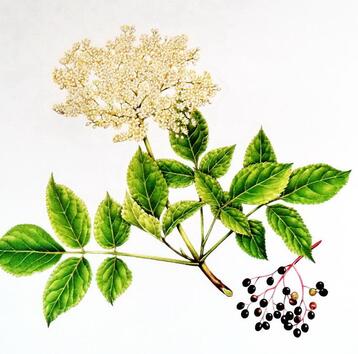|
The genus Sambucus numbers some thirty species distributed throught the world. It is a very propular medicininal plant and has been since ancient times. The elder tree has been known as a medicine chest in its own right with all parts of this amazing plant being used. This herb that assists the human body from head to toe and has a long standing presence in Herbalism. Shakespeare makes reference to the elder tree in Cymbeline. And in medieval times the tree was a traditional symbol for mourning and green branches were commonly seen at grave sites during this time. Elder berry has been shown to be very useful for colds and flus and has been shown in clinical studies to strengthen cell membranes which protects against viral penetration. Furthermore, elder berry was shown to be effective against 10 strains of the influenza virus. It also reduced the duration of flu symptoms to 3 to 4 days in a double-blind, placebo-controlled, randomized study. Parts Used: Berries, flowers, (leaves, bark, inner bark, root – may contain some toxic principles, do not self-dose) Family: Adoxaceae Actions: Anti-Inflammatory Diaphoretic Laxative Diuretic (flowers) Anti-Rheumatic Anti-Viral Alterative Emollient Astringent Nutritive – Contains Vitamin A, C, Calcium, Potassium, and Iron Antiseptic Mild Laxative Cooling (Flower) Slightly Blood Thinning (Flower) Soothing (Flower) Stimulating (Flower) Slightly Tonic (Flower) Anti-fungal (Leaves/Topical only) Blood Building (Berries) Chemical Constituents: Flavonoids (anti-inflammatory, immune stimulating) - Rutin and Quercetin (Flowers) Triterpenes Volatile oils Sterols Tannins (Flowers) Mucilage (Berries and Flowers) Pectin Sugars Phenolic compounds Anthocyanins (Berry) Vit A, B, and C, Iron, Sugars What are its uses?Head, Ears, Eyes, Nose, and Throat:
Kidneys/Urinary:
Cardiovascular/Blood:
Reproductive System:
Nervous System/Mental Health:
Specific Diseases/States/Infections/Viruses:
Safety Concerns and Contraindications
References:
0 Comments
Leave a Reply. |
Petra Sovcov is not a Medical Doctor (MD) nor a Naturopath (ND), she is a Clinical Herbal Therapist (CHT) and holds a Doctorate in Natural Medicine (DNM). The suggestions or recommendations made on this site are not meant to be a substitute for advice from your MD, or as a substitute for any prescriptions you may be taking. Suggestions followed will be the responsibility of the reader, and are stated with the intention of interest and education only. If you have a health issue, please see your primary care physician (MD) first and foremost. Categories
All
Archives
July 2024
|


 RSS Feed
RSS Feed